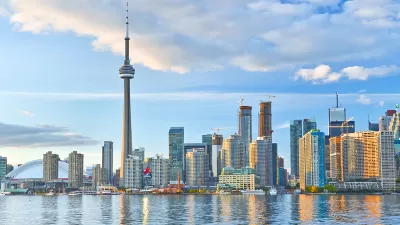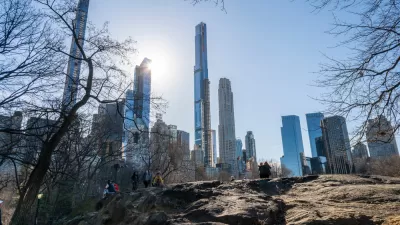No skyline in North America has changed as drastically as Toronto’s in recent decades. A slate of new skyscraper proposals, called a “skyscraper race” by observers, could continue the trend.

Developer Pinnacle International is proposing two supertall skyscrapers—one at 92 stories and other at 105 stories—potentially rising among the two or three tallest buildings in the city.
Pinnacle is seeking an increase in height for both buildings, already approved at heights 12 and ten stories shorter, respectively, at the current site of the Toronto Star building. If approved at the newly proposed heights, the buildings would jump past the approved development of “The One,” proposed for the corner of Yonge and Bloor.
The taller of Pinnacle’s two buildings, called SkyTower, would reach 346 meters (just over 1,135 feet). SkyTower would be the first building in Canada to exceed 100 stories.
A paywalled article by May Warren, linked below, provides more local commentary on the city’s new skyscraper race. As noted by Warren, the city’s famous CN Tower, which reaches 553 meters (1,815 feet) doesn’t qualify for the discussion, though it is much taller than any of the buildings reported here.
“The CN Tower doesn’t technically count as a building, he added. According to the Council on Tall Buildings and Urban Habitat, to be considered a building at least half of its height must be occupiable. Telecommunications or observation towers don’t make the cut,” writes Warren.
Toronto has long outpaced all other North American cities in the scope of skyscraper construction. Planetizen documented Toronto’s development pace with articles in 2015 and 2012.
FULL STORY: In the race to build Toronto’s first ‘super tall’ skyscraper, a new proposal hits 105 storeys [paywall]

Trump Administration Could Effectively End Housing Voucher Program
Federal officials are eyeing major cuts to the Section 8 program that helps millions of low-income households pay rent.

Planetizen Federal Action Tracker
A weekly monitor of how Trump’s orders and actions are impacting planners and planning in America.

Ken Jennings Launches Transit Web Series
The Jeopardy champ wants you to ride public transit.

Crime Continues to Drop on Philly, San Francisco Transit Systems
SEPTA and BART both saw significant declines in violent crime in the first quarter of 2025.

How South LA Green Spaces Power Community Health and Hope
Green spaces like South L.A. Wetlands Park are helping South Los Angeles residents promote healthy lifestyles, build community, and advocate for improvements that reflect local needs in historically underserved neighborhoods.

Sacramento Plans ‘Quick-Build’ Road Safety Projects
The city wants to accelerate small-scale safety improvements that use low-cost equipment to make an impact at dangerous intersections.
Urban Design for Planners 1: Software Tools
This six-course series explores essential urban design concepts using open source software and equips planners with the tools they need to participate fully in the urban design process.
Planning for Universal Design
Learn the tools for implementing Universal Design in planning regulations.
Heyer Gruel & Associates PA
Ada County Highway District
Institute for Housing and Urban Development Studies (IHS)
City of Grandview
Harvard GSD Executive Education
Toledo-Lucas County Plan Commissions
Salt Lake City
NYU Wagner Graduate School of Public Service





























